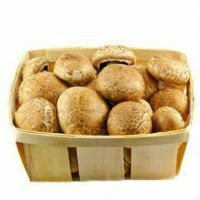
Champignons are useful, tasteful mushrooms that can be grown in an artificial environment, for example, indoors or on the plot. The technology of growing champignons at home has been worked out for decades. To collect a harvest of environmentally friendly and selected champignons, you must follow the important rules of cultivation.
Where to grow mushrooms
If you decided to try growing champignons at home or at the dacha, the first thing you need to do is to pre-where mushrooms will grow. Grow a small amount of mushrooms can be in:
- basement,
- garage,
- shed,
- greenhouse.
The main condition is to create an environment with good ventilation, high humidity and moderate temperature.
For growing mushrooms at home you will need:
- wooden or plastic containers for the substrate;
- fans for ventilation;
- thermometers for measuring air and soil temperature.
Champignons also grow on the open ground. If you decide to plant mushrooms in your garden, then choose places in the shade and penumbra - under bushes, trees, in raspberries, from the shaded sides of fences and farm buildings, that is, in places hidden from direct sunlight.
To make a mushroom picking, it is usually placed in soil in April or August, as in the hot months fruit bodies are not formed.
Substrate preparation
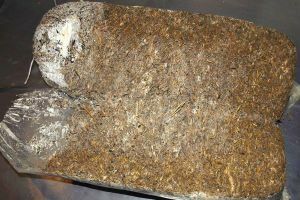 The most important thing in growing champignons is substrate preparation. It is from the quality and properly composted will depend on both the quality and quantity of the crop. The main ideal constituent of the substrate for mushrooms is horse manure.
The most important thing in growing champignons is substrate preparation. It is from the quality and properly composted will depend on both the quality and quantity of the crop. The main ideal constituent of the substrate for mushrooms is horse manure.
But today, as with the same success, manure of cattle, sheep, pigs and birds is used. Another important component of the compost is fresh, non-forbidden straw or hay. As various nutritional supplements, potato, tomato or pumpkin tops are added to the substrate. Also, the compost must be saturated with nitrogen-containing components, such as ammonium sulfate or urea.
In addition, without fail, different mineral additives are introduced into the substrate - superphosphate, chalk or gypsum. There are elements with common nutrients that are not superfluous in the soil, so many add bran, cotton processing waste or bone meal.
On the mycelium, the area of about two square meters is taken:
- 100 kilograms of straw,
- 2 kilograms of superphosphate and urea,
- 5 kilograms of chalk,
- 8 kilograms of gypsum.
All this is connected with 170-200 kilograms of manure and in the end it turns out about 300 kilograms of substrate.
Compost is prepared in the open air, as when mixing all components begins the process of fermentation, which produces a characteristic ammonia odor. The process of making the compost lasts about 20-23 days, after which it is obtained completely prepared soil for planting the mycelium.
For substrate preparation:
- Straw is soaked for a day in water.
- Straw and manure are stacked in a row.
- Each straw layer must be additionally moistened with urea and superphosphate.
- Compost is mixed and left for fermentation for 3-5 days, during which the mixture warms up to 50-70 ° C.
- With a periodicity of 5-7 days make a break in the mixture - the compost is mixed well and additional nutrients are added to it.
- The last break is made on the 14-16 day, then give the compost to warm up to 50-60 ° C and lay out on the prepared boxes.
Planting of mushroom mycelium
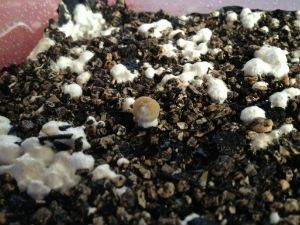 Mushroom mycelium is planted to a depth of no more than 10 centimeters in a compost that has cooled down to 23-25 ° C.In the first two weeks after planting, it is very important not to allow the temperature of the substrate to rise to 28-30 ° C and maintain high air humidity. When the temperature rises, the room should be cooled without creating drafts.
Mushroom mycelium is planted to a depth of no more than 10 centimeters in a compost that has cooled down to 23-25 ° C.In the first two weeks after planting, it is very important not to allow the temperature of the substrate to rise to 28-30 ° C and maintain high air humidity. When the temperature rises, the room should be cooled without creating drafts.
For maintenance of humidity it is recommended to spray the substrate, as well as to humidify the walls and floor of the room.
After two weeks, the mycelium should grow well and already at this stage it should be covered with a layer of soil 3-4 centimeters thick, which should consist of half of turf ground and peat, and half of chalk or loam soil, previously scalded with boiling water.
to table of contents ^Removal of fruit bodies
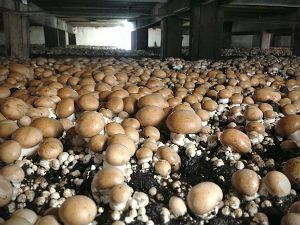 After the incubation period, 3-5 days after coating with soil, the mycelium passes into the stage of forcing fruit bodies. The further temperature regime of the substrate should be kept within 20-22 ° C, while the air temperature should be gradually lowered to 13-16 ° C at a humidity of 60-75%.
After the incubation period, 3-5 days after coating with soil, the mycelium passes into the stage of forcing fruit bodies. The further temperature regime of the substrate should be kept within 20-22 ° C, while the air temperature should be gradually lowered to 13-16 ° C at a humidity of 60-75%.
In such an environment, the first crop will be collected in two weeks.
Harvesting
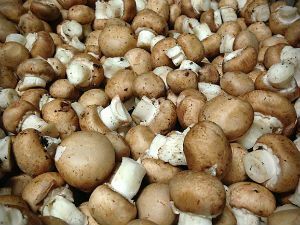 The long-awaited moment of harvesting mushrooms begins three to four months after plantingand lasts about 2 months. Do not overtake the fruit. Mushrooms should be collected when the base of the cap is still covered with a white film and brown plates are not visible. Each champignon should be carefully unscrewed from the soil, and not cut, like all mushroom pickers do.
The long-awaited moment of harvesting mushrooms begins three to four months after plantingand lasts about 2 months. Do not overtake the fruit. Mushrooms should be collected when the base of the cap is still covered with a white film and brown plates are not visible. Each champignon should be carefully unscrewed from the soil, and not cut, like all mushroom pickers do.
The fact is that the remaining leg after the cut may get a bacterium, which will be fatal for the whole mycelium. The place from which the mushroom was wrung out should be sprinkled with earth.
It is important to collect the whole crop without residue, which will provoke the pasture of a new wave of mushrooms.
The main amount of champignons is expelled in the first three waves, after which the yield will gradually decrease.
Undoubtedly, growing champignons in an artificial environment is a laborious process that requires knowledge and time. But everything can be learned, besides it is an exciting activity that will eventually yield a useful and tasty result.
